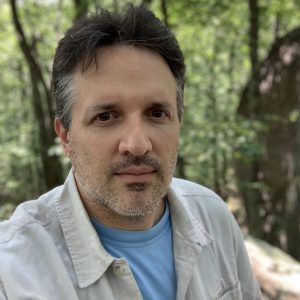The 2,350-acre Bull Run Mountain Natural Area Preserve in Fauquier and Prince William counties is well known as a treasure trove of recreational and natural resources located just 35 miles west of Washington, D.C. Less known to the public, but just as valuable, are the historic structures on the property. One of these structures is an old stone house of unknown origin. Recently, the Virginia Outdoors Foundation has been working with historians and archeologists to uncover its past. What we are learning is that the house might be older and more significant than anyone thought.
In October 2012, Wendy Wheatcraft, a preservation planner for Fauquier County, visited the house to look for clues to its construction date. People familiar with the structure always assumed it was old, but nobody knew whether it dated back 100 years, 200 years, or more. Unfortunately, a heavy-handed renovation was performed in the 1960s. The structure was so altered that it now lacks interior features that might provide those clues.
Wheatcraft has since conducted extensive deed research and uncovered some missing pieces of the property’s past.
In the 18th century, the property was part of the 16,000-acre Bull Run and Battle River tract owned by George and James Mercer. Colonel George Mercer was a Virginia aristocrat who fell into severe financial straits primarily due to land speculation losses. In 1773, he mortgaged some 4,000 acres of his Bull Run Mountains land to an Englishwoman named Mary Wroughton. Just a year later, Mercer was unable to meet the terms of the mortgage and he was ordered to sell the 4,000 acres along with additional land in Frederick County.
Because Mercer was living in England at the time, the sale was managed by his lifelong friend, George Washington. Washington arranged to have the properties subdivided and personally handled the auction on November 21, 1774. Records reveal that the auction was a frustrating experience for Washington, who complained the land had “a good deal of exceeding poor and broken ground on it.” Bids were nowhere near the original estate valuation, and Washington stated, “There was no help for it; everything that could be done, was done, to dispose of it to the best advantage; in attempting which, I had three Lots of the Land … left upon my hands.”
The 470 acres that includes the area of the stone house was purchased by a man named John Monday. Could the house have been built by him and his household? If so, that would date the house to before the Revolutionary War.
In 1802, James Battson purchased 420 acres from Monday. While the deed does not list improvements on the property, it does mention a walled cemetery — again, hinting that perhaps the stone house was where the Monday family resided.
Much research still needs to be done. One of the avenues yet to be explored is archaeology. On October 11–12, 2013, Fauquier County and VOF will jointly sponsor public archaeology days on the site. Before the event, professional archaeologists will identify the most promising features on the site for revealing the most information. Then, they will lead teams of volunteers to perform additional archaeological study.
VOF’s Bull Run Mountains stewardship committee devoted one of their workdays to the stone house recently. The house narrowly avoided damage last summer when a large portion of a tree blew down close to the structure. Our committee members removed the tree and other aged trees that posed a danger to the house.
VOF will continue working to uncover the origin of the stone house. We invite anyone with knowledge of the structure’s past to contact us. Citizens who are interested in volunteering at the Bull Run Mountains, either during the upcoming archaeology days in October or for any project (such as maintaining trails, picking up litter, etc.) should contact VOF Owned Lands manager Amanda Scheps, ascheps@vofonline.org, (540) 347-7727 ext. 227.
